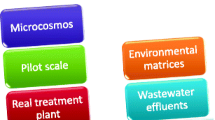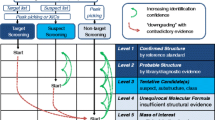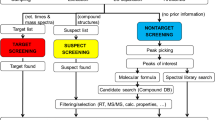Abstract
This review summarizes the advances in environmental analysis by liquid chromatography–high-resolution mass spectrometry (LC–HRMS) during the last decade and discusses different aspects of their application. LC–HRMS has become a powerful tool for simultaneous quantitative and qualitative analysis of organic pollutants, enabling their quantitation and the search for metabolites and transformation products or the detection of unknown compounds. LC–HRMS provides more information than low-resolution (LR) MS for each sample because it can accurately determine the mass of the molecular ion and its fragment ions if it can be used for MS–MS. Another advantage is that the data can be processed using either target analysis, suspect screening, retrospective analysis, or non-target screening. With the growing popularity and acceptance of HRMS analysis, current guidelines for compound confirmation need to be revised for quantitative and qualitative purposes. Furthermore, new commercial software and user-built libraries are required to mine data in an efficient and comprehensive way. The scope of this critical review is not to provide a comprehensive overview of the many studies performed with LC–HRMS in the field of environmental analysis, but to reveal its advantages and limitations using different workflows.



Similar content being viewed by others
References
Eichhorn P, Pérez S, Barceló D (2012) Time-of-flight mass spectrometry versus orbitrap-based mass spectrometry for the screening and identification of drugs and metabolites: is there a winner? Compr Anal Chem 58:217–272
J. Aceña, D. Rivas, B. Zonja, S. Péreza, D. Barcelóa, Liquid Chromatography–Mass Spectrometry: Quantification and Confirmation Aspects
Kaufmann A, Butcher P, Maden K, Walker S, Widmer M (2011) Quantitative and confirmative performance of liquid chromatography coupled to high‐resolution mass spectrometry compared to tandem mass spectrometry. Rapid Commun Mass Spectrom 25:979–992
Hernández F, Sancho J, Ibáñez M, Abad E, Portolés T, Mattioli L (2012) Current use of high-resolution mass spectrometry in the environmental sciences. Anal Bioanal Chem 403:1251–1264
Krauss M, Singer H, Hollender J (2010) LC–high resolution MS in environmental analysis: from target screening to the identification of unknowns. Anal Bioanal Chem 397:943–951
Hernández F, Ibáñez M, Bade R, Bijlsma L, Sancho J (2014) Investigation of pharmaceuticals and illicit drugs in waters by liquid chromatography-high-resolution mass spectrometry. TrAC Trends Anal Chem 63:140–157
Agüera A, Martínez Bueno M, Fernández-Alba A (2013) New trends in the analytical determination of emerging contaminants and their transformation products in environmental waters. Environ Sci Pollut Res 20:3496–3515
Kaufmann A, Butcher P, Maden K, Walker S, Widmer M (2010) Comprehensive comparison of liquid chromatography selectivity as provided by two types of liquid chromatography detectors (high resolution mass spectrometry and tandem mass spectrometry):“Where is the crossover point?”. Anal Chim Acta 673:60–72
Ferrer I, Thurman EM (2012) Analysis of 100 pharmaceuticals and their degradates in water samples by liquid chromatography/quadrupole time-of-flight mass spectrometry. J Chromatogr A 1259:148–157
Shrivastava A, Gupta VB (2011) Methods for the determination of limit of detection and limit of quantitation of the analytical methods. Chronicles of Young Sci 2:21
Farré M, Picó Y, Barceló D (2014) Application of ultra-high pressure liquid chromatography linear ion-trap orbitrap to qualitative and quantitative assessment of pesticide residues. J Chromatogr A 1328:66–79
Wille K, Claessens M, Rappé K, Monteyne E, Janssen CR, De Brabander HF, Vanhaecke L (2011) Rapid quantification of pharmaceuticals and pesticides in passive samplers using ultra high performance liquid chromatography coupled to high resolution mass spectrometry. J Chromatogr A 1218:9162–9173
Padilla-Sánchez JA, Plaza-Bolaños P, Romero-González R, Grande-Martínez Á, Thurman EM, Garrido-Frenich A (2012) Innovative determination of polar organophosphonate pesticides based on high‐resolution Orbitrap mass spectrometry. J Mass Spectrom 47:1458–1465
Vergeynst L, Haeck A, De Wispelaere P, Van Langenhove H, Demeestere K (2015) Multi-residue analysis of pharmaceuticals in wastewater by liquid chromatography–magnetic sector mass spectrometry: Method quality assessment and application in a Belgian case study. Chemosphere 119:S2–S8
Commission E (2002) Commission Decision 2002/657/EC of 12 August 2002 implementing Council Directive 96/23/EC concerning the performance of analytical methods and the interpretation of results. Off J Eur Comm L 221:8–36
Nurmi J, Pellinen J (2011) Multiresidue method for the analysis of emerging contaminants in wastewater by ultra performance liquid chromatography–time-of-flight mass spectrometry. J Chromatogr A 1218:6712–6719
Wille K, Bussche JV, Noppe H, De Wulf E, Van Caeter P, Janssen C, De Brabander H, Vanhaecke L (2010) A validated analytical method for the determination of perfluorinated compounds in surface-, sea-and sewagewater using liquid chromatography coupled to time-of-flight mass spectrometry. J Chromatogr A 1217:6616–6622
Lara-Martín PA, González-Mazo E, Brownawell BJ (2011) Multi-residue method for the analysis of synthetic surfactants and their degradation metabolites in aquatic systems by liquid chromatography–time-of-flight-mass spectrometry. J Chromatogr A 1218:4799–4807
Farré M, Gros M, Hernandez B, Petrovic M, Hancock P, Barceló D (2008) Analysis of biologically active compounds in water by ultra‐performance liquid chromatography quadrupole time‐of‐flight mass spectrometry. Rapid Commun Mass Spectrom 22:41–51
Nielen M, Van Engelen M, Zuiderent R, Ramaker R (2007) Screening and confirmation criteria for hormone residue analysis using liquid chromatography accurate mass time-of-flight, Fourier transform ion cyclotron resonance and orbitrap mass spectrometry techniques. Anal Chim Acta 586:122–129
Makarov A, Scigelova M (2010) Coupling liquid chromatography to Orbitrap mass spectrometry. J Chromatogr A 1217:3938–3945
K. Comstock, Y (2011) Huang, Multiple fragmentation methods for small molecule characterization on a dual pressure linear ion trap Orbitrap hybrid mass spectrometer, Application Note, 540
Coscollà C, León N, Pastor A, Yusà V (2014) Combined target and post-run target strategy for a comprehensive analysis of pesticides in ambient air using liquid chromatography-Orbitrap high resolution mass spectrometry. J Chromatogr A 1368:132–142
Cahill MG, Dineen BA, Stack MA, James KJ (2012) A critical evaluation of liquid chromatography with hybrid linear ion trap—Orbitrap mass spectrometry for the determination of acidic contaminants in wastewater effluents. J Chromatogr A 1270:88–95
Negreira N, López de Alda M, Barceló D (2015) Degradation of the cytostatic etoposide in chlorinated water by liquid chromatography coupled to quadrupole-Orbitrap mass spectrometry: Identification and quantification of by-products in real water samples. Sci Total Environ 506–507:36–45
Chalcraft KR, Lee R, Mills C, Britz-McKibbin P (2009) Virtual Quantification of Metabolites by Capillary Electrophoresis-Electrospray Ionization-Mass Spectrometry: Predicting Ionization Efficiency Without Chemical Standards. Anal Chem 81:2506–2515
Kruve A, Kaupmees K, Liigand J, Leito I (2014) Negative electrospray ionization via deprotonation: predicting the ionization efficiency. Anal Chem 86:4822–4830
Oss M, Kruve A, Herodes K, Leito I (2010) Electrospray ionization efficiency scale of organic compounds. Anal Chem 82:2865–2872
B. Zonja, J. Aceña, S. Pérez, D. Barceló (2013) Chapter 16 - Methods for Elucidation of Transformation Pathways: Identification of Intermediate Products, Chiral, and Isotope-Ratio Mass Spectrometry Analysis, in: D.B. Mira Petrovic, P. Sandra (Eds.) Comprehensive Analytical Chemistry, Elsevier, pp. 593–610
Eichhorn P, Ferguson PL, Pérez S, Aga DS (2005) Application of Ion Trap-MS with H/D Exchange and QqTOF-MS in the Identification of Microbial Degradates of Trimethoprim in Nitrifying Activated Sludge. Anal Chem 77:4176–4184
Pérez S, Eichhorn P, Celiz MD, Aga DS (2006) Structural Characterization of Metabolites of the X-ray Contrast Agent Iopromide in Activated Sludge Using Ion Trap Mass Spectrometry. Anal Chem 78:1866–1874
Pérez S, Barceló D (2008) First Evidence for Occurrence of Hydroxylated Human Metabolites of Diclofenac and Aceclofenac in Wastewater Using QqLIT-MS and QqTOF-MS. Anal Chem 80:8135–8145
Aceña J, Pérez S, Gardinali P, Abad JL, Eichhorn P, Heuett N, Barceló D (2014) Structure elucidation of phototransformation products of unapproved analogs of the erectile dysfunction drug sildenafil in artificial freshwater with UPLC-Q Exactive-MS. J Mass Spectrom 49:1279–1289
Zonja B, Gonçalves C, Pérez S, Delgado A, Petrovic M, Alpendurada MF, Barceló D (2014) Evaluation of the phototransformation of the antiviral zanamivir in surface waters through identification of transformation products. J Hazard Mater 265:296–304
Rousu T, Herttuainen J, Tolonen A (2010) Comparison of triple quadrupole, hybrid linear ion trap triple quadrupole, time-of-flight and LTQ-Orbitrap mass spectrometers in drug discovery phase metabolite screening and identification in vitro – amitriptyline and verapamil as model compounds. Rapid Commun Mass Spectrom 24:939–957
Moschet C, Piazzoli A, Singer H, Hollender J (2013) Alleviating the reference standard dilemma using a systematic exact mass suspect screening approach with liquid chromatography-high resolution mass spectrometry. Anal Chem 85:10312–10320
Hug C, Ulrich N, Schulze T, Brack W, Krauss M (2014) Identification of novel micropollutants in wastewater by a combination of suspect and nontarget screening. Environ Pollut 184:25–32
Schymanski EL, Jeon J, Gulde R, Fenner K, Ruff M, Singer HP, Hollender J (2014) Identifying small molecules via high resolution mass spectrometry: communicating confidence. Environ Sci Technol 48:2097–2098
Wode F, van Baar P, Dünnbier U, Hecht F, Taute T, Jekel M, Reemtsma T (2015) Search for over 2000 current and legacy micropollutants on a wastewater infiltration site with a UPLC-high resolution MS target screening method. Water Res 69:274–283
Bushee JL, Argikar UA (2011) An experimental approach to enhance precursor ion fragmentation for metabolite identification studies: application of dual collision cells in an orbital trap. Rapid Commun Mass Spectrom 25:1356–1362
Zonja B, Delgado A, Pérez S, Barceló D (2015) LC-HRMS Suspect Screening for Detection-Based Prioritization of Iodinated Contrast Media Photodegradates in Surface Waters. Environ Sci Technol 49:3464–3472
Kern S, Fenner K, Singer HP, Schwarzenbach RP, Hollender J (2009) Identification of transformation products of organic contaminants in natural waters by computer-aided prediction and high-resolution mass spectrometry. Environ Sci Technol 43:7039–7046
Kern S, Baumgartner R, Helbling DE, Hollender J, Singer H, Loos MJ, Schwarzenbach RP, Fenner K (2010) A tiered procedure for assessing the formation of biotransformation products of pharmaceuticals and biocides during activated sludge treatment. J Environ Monit 12:2100–2111
Wang J, Gardinali PR (2014) Identification of phase II pharmaceutical metabolites in reclaimed water using high resolution benchtop Orbitrap mass spectrometry. Chemosphere 107:65–73
A.A. Bletsou, J. Jeon, J. Hollender, E. Archontaki, N.S. Thomaidis (2015) Targeted and non-targeted liquid chromatography-mass spectrometric workflows for identification of transformation products of emerging pollutants in the aquatic environment, TrAC Trends Anal Chem
Jeon J, Kurth D, Hollender J (2013) Biotransformation Pathways of Biocides and Pharmaceuticals in Freshwater Crustaceans Based on Structure Elucidation of Metabolites Using High Resolution Mass Spectrometry. Chem Res Toxicol 26:313–324
Gómez-Ramos MM, Pérez-Parada A, García-Reyes JF, Fernández-Alba AR, Agüera A (2011) Use of an accurate-mass database for the systematic identification of transformation products of organic contaminants in wastewater effluents. J Chromatogr A 1218:8002–8012
Zedda M, Zwiener C (2012) Is nontarget screening of emerging contaminants by LC-HRMS successful? A plea for compound libraries and computer tools. Anal Bioanal Chem 403:2493–2502
Kind T, Fiehn O (2007) Seven Golden Rules for heuristic filtering of molecular formulas obtained by accurate mass spectrometry. BMC Bioinforma 8:105
Chiaia-Hernandez AC, Schymanski EL, Kumar P, Singer HP, Hollender J (2014) Suspect and nontarget screening approaches to identify organic contaminant records in lake sediments. Anal Bioanal Chem 406:7323–7335
Hogenboom A, Van Leerdam J, de Voogt P (2009) Accurate mass screening and identification of emerging contaminants in environmental samples by liquid chromatography–hybrid linear ion trap Orbitrap mass spectrometry. J Chromatogr A 1216:510–519
Schymanski EL, Singer HP, Longrée P, Loos M, Ruff M, Stravs MA, Ripollés Vidal C, Hollender J (2014) Strategies to characterize polar organic contamination in wastewater: exploring the capability of high resolution mass spectrometry. Environ Sci Technol 48:1811–1818
Weiss J, Simon E, Stroomberg G, de Boer R, de Boer J, van der Linden S, Leonards PG, Lamoree M (2011) Identification strategy for unknown pollutants using high-resolution mass spectrometry: Androgen-disrupting compounds identified through effect-directed analysis. Anal Bioanal Chem 400:3141–3149
Vergeynst L, Van Langenhove H, Joos P, Demeestere K (2014) Suspect screening and target quantification of multi-class pharmaceuticals in surface water based on large-volume injection liquid chromatography and time-of-flight mass spectrometry. Anal Bioanal Chem 406:2533–2547
Martínez Bueno MJ, Ulaszewska MM, Gomez MJ, Hernando MD, Fernández-Alba AR (2012) Simultaneous measurement in mass and mass/mass mode for accurate qualitative and quantitative screening analysis of pharmaceuticals in river water. J Chromatogr A 1256:80–88
Hernández F, Ibáñez M, Portolés T, Cervera MI, Sancho JV, López FJ (2015) Advancing towards universal screening for organic pollutants in waters. J Hazard Mater 282:86–95
Acknowledgments
S. Pérez acknowledges the contract from the Ramon y Cajal Program of the Spanish Ministry of Economy and Competitiveness. This work has been financially supported by the Generalitat de Catalunya (Consolidated Research Groups “2014 SGR 418 - Water and Soil Quality Unit”, 2014 SGR 291.
Author information
Authors and Affiliations
Corresponding author
Additional information
Published in the topical collection High-Resolution Mass Spectrometry in Food and Environmental Analysis with guest editor Aldo Laganà.
Rights and permissions
About this article
Cite this article
Aceña, J., Stampachiacchiere, S., Pérez, S. et al. Advances in liquid chromatography–high-resolution mass spectrometry for quantitative and qualitative environmental analysis. Anal Bioanal Chem 407, 6289–6299 (2015). https://doi.org/10.1007/s00216-015-8852-6
Received:
Revised:
Accepted:
Published:
Issue Date:
DOI: https://doi.org/10.1007/s00216-015-8852-6




